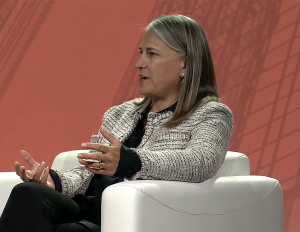Lending Trends Panel Kicks Off ULI Spring Meeting
Leading investors discussed what's ahead for the debt markets during the opening panel of the annual event.
The real estate capital markets have clearly changed from a few months ago. While equity dollars continue to pour into real estate, lenders are pausing in light of rising interest rates, climbing Treasury rates, worsening inflation and global uncertainty.
That shift in the debt markets and its impacts on the overall investment market was the topic of the opening panel at the ULI Spring Meeting titled: “Capital Flows in Uncertain Times.” The panel featured Dune Real Estate Partners LP President & CIO Cia Buckley Marakovits, Bain Capital Managing Director Kavindi Wickremage, and BentallGreenOak President Amy Price.
Real estate is typically a levered asset class so the increased cost of debt and lender hesitancy is having a noticeable effect on the buying and selling of assets and, in some cases, values.
“It definitely is a market that, as a buyer, you have an advantage if you can be unleveraged, if you can think differently about your capital structure, than if you are dependent on the debt markets,” said Price. “We are definitely seeing a shift in the buyer universe, again, based on how people think about their capital structure.”
The debt market area most “disrupted” by the interest rate hikes and global uncertainty has been CMBS and CLOs. “That is a big pool of capital,” said Marakovits. “It is smaller than it was in the heyday, but it is still a valuable tool. That still seems to be a little frozen. Will there be other capital sources to make that up? It still feels like we are going to be in a bit of a pause.”
Lender caution is not unwarranted, however, the speakers acknowledged, and it will hopefully cause borrowers to be pickier and choosier.
“Lenders are being quite prudent, quite reasonable,” said Price. “They are working with borrowers and owners on financings already in place. I don’t think they are getting out of the market, but everyone is trying to think a little bit differently and I think that shows a level of maturity and sophistication that is positive.”
Where Is the Growth?
One big concern for lenders is cap rates since there are a lot of inflationary pressures on net operating income today, including higher costs for wages, utilities, real estate taxes, insurance and anything impacted by supply chain issues. Another question for lenders and borrowers is income growth, which will be necessary to offset the increased cost of debt and meet investor expectations.
On one hand, the U.S. has been a great growth story over the past few years. “Part of the reason we have so much inflation we have such strong demand,” said Wickremage. “And that really is a positive thing. It really is the reaction to that by the Fed—which is very strong rate increases—that we are all reacting to.”
But, in many cases, sellers received high prices for that growth. Rising costs, and general economic uncertainty could undermine growth for current owners. “When you think of how much growth, you need to, one, stay even, and then, to get ahead,” said Marakovits. “I feel good about what is going on in the U.S., but it is tough, in a market where everything is going up, to just bank on growth.”
Where can growth be found today? At Bain, Wickremage said, growth is defined as what is “only accelerating” and the Sun Belt is among those areas of consistent growth.
“Do I think that will continue? Yes, but there are issues like housing prices in Austin that will slow that,” she said.
Another area of growth that can be counted on is logistics. For office and retail, meanwhile, there will be a continued bifurcation between the haves and the have-nots.
“We were all raised on location, location, location,” Price said of office. “Now it is experience, experience and location.”








You must be logged in to post a comment.